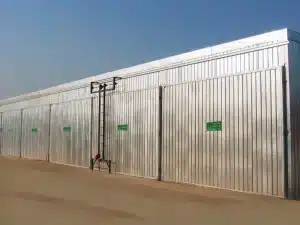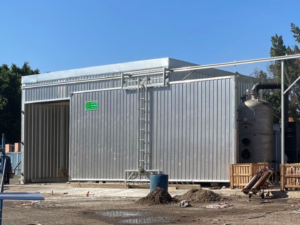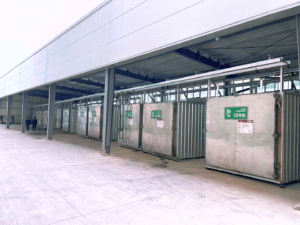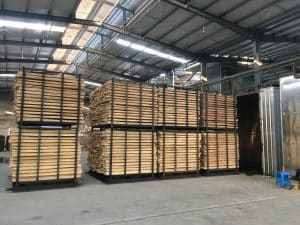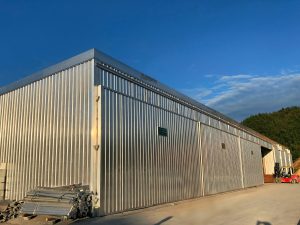
From forests to furniture, from logs to refined flooring, every board hides a challenge: Moisture. And the silent hero behind every strong, stable, beautiful piece of wood? Kiln drying. It doesn’t make noise, but it makes all the difference — preventing cracks, warps, and wasted effort. If you turn wood into something that lasts, kiln drying is where your quality begins.
In this article, we’ll explore what kiln drying is, how it works, and why it’s essential for wood stability and durability.
Table of Contents
What Is Kiln Drying?
Kiln drying is a precision-controlled process where wood is dried in heated chambers called kilns. By regulating temperature, humidity, and airflow, moisture content in wood is reduced from fresh levels down to a stable, workable range—typically between 6% and 12%—in a matter of days or weeks.
Compared to natural air drying, kiln drying is faster and more uniform, minimizing defects such as warping, cracking, and mold growth.
Moisture Past the Kiln
1. How Moisture Evaporates
Kiln drying uses heated air to turn the water inside the wood into vapor. As the kiln maintains a temperature differential (dry bulb – wet bulb), moisture evaporates from the surface and diffuses from the interior.
2. Free Water Removal: First, water between wood cells (free water) is removed. This is fast and easier. Bound Water Removal: Then, water inside the cell walls (bound water) is slowly drawn out. This stage needs careful control to avoid cracks or warping.
3. Air Circulation and Heat
Powerful fans of drying kilns move hot air through stacked lumber at high speed. This ensures all boards dry evenly, avoiding “hot spots” or wet zones.
4. Humidity Control
If the surface dries too fast, it can trap moisture inside (called “case hardening”). The kiln carefully controls humidity using steam or exhaust vents to balance drying speed and wood stability.
Find out more about Wood moisture content (MC) at how to measure and control the wood moisture content.
Why Kiln Dry Wood? Benefits of Kiln Dried Wood
Wood’s natural hygroscopic nature means it absorbs and releases moisture, making untreated green wood highly unstable. Freshly cut timber can hold 30–200% MC, leading to: Warping & Splitting, Pest & Decay Risks, and Processing Failures. Kiln drying mitigates these issues by systematically driving out moisture, and its key benefits include:
✅ Minimized Defects: By carefully controlling temperature, humidity, and airflow, kiln drying greatly reduces risks of warping, cracking, end checks, and case hardening.
✅ Improved Dimensional Stability: Properly kiln-dried wood maintains its shape and size better over time, even in varying climates — critical for flooring, cabinetry, and joinery.
✅ Pest & Fungi Elimination: Sustained high temperatures effectively kill larvae, mold spores, and fungi, making kiln-dried wood compliant with export standards (e.g., ISPM-15 standards).
✅ Enhanced Adhesion & Finishing: Dry wood offers better bonding for glues, cleaner cuts, and more even absorption of stains and finishes, ensuring higher product quality.
✅ Faster Production Cycle: Unlike air drying, which can take months to years, kiln drying integrates seamlessly into modern manufacturing timelines, boosting efficiency and inventory turnover.
✅ Moisture Uniformity: Advanced kilns maintain MC variation within ±1%, ensuring consistency across boards — a key factor in mass production and automated assembly.
The Kiln Drying Process: Step-by-Step

Sorting & Preparation of Timber
- Logs are categorized by species (e.g., pine, oak), thickness, and end use (e.g., flooring requires ≤8% MC).
- Sawn boards are stacked with spacers for airflow, preventing mold and uneven drying.
Controlled Lumber Drying Phases
- Preheating (40–60°C): High humidity relaxes wood fibers, ideal for thick timbers or prone species like mahogany.
- Primary Drying (80–120°C): Forced hot air removes free water, with humidity gradually reduced to draw moisture from the core. 120°C works for radiata pines
- Equilibrium & Cooling: Kiln conditions mimic the final use environment (e.g., 20°C, 50% RH) to stabilize MC, followed by slow cooling to prevent stress.
Quality Assurance
- Post-drying, lumber is planed, graded, and tested for MC uniformity (typically ≤1% variation per kiln load).
Kiln Drying vs. Air Drying:Which Is Better?
| Type | Air Drying | Kiln Drying |
| Speed | Slow (6 months–years) | Fast (days– weeks) |
| MC Control | Dependent on climate | Precise (6–12% target) |
| Defect Risk | High (warping, mold) | Low (regulated airflow) |
| Cost Efficiency | Low upfront, high waste | Higher investment, lower waste |
| Ideal For | Low-value lumber, firewood | Furniture, flooring, pianos (high-precision needs) |
How to Maintain Kiln Dried Wood After Drying
Even kiln-dried wood adjusts to environmental humidity. For example:
- A kiln-dried oak floor in a humid climate may absorb moisture, causing cupping; in dry air, it may shrink and gap.
Solutions:
- Acclimation: Let lumber adjust to site conditions (e.g., 7 days for flooring) before installation.
- Advanced Testing: Tools like microwave and stress-wave technology detect hidden moisture, ensuring no “false dry” timber reaches projects.
Our Kiln Solutions: Tech's Energy-Efficient Drying System
Tech’s drying kiln systems optimize kiln drying for efficiency and sustainability:
- Precision: Precise control of temperature, humidity and moisture content trhough out the drying process. Generate custom drying schedules, cutting energy use by 30% compared to traditional kilns.
- Innovative Technology: Air source and waste heat recovery integration align with EU goals to reduce timber drying cost by 40%.
- Reliable Results: Trusted by 1,000+ clients, drying success for lumber and timber, minimizing rework.
Conclusion: Why Kiln Drying Matters
Kiln drying isn’t just a step—it’s the science that turns raw wood into reliable lumber and timber. With Tech’s innovative kiln dryers, businesses achieve precision, sustainability, and consistency, ensuring every piece of wood meets the highest standards. For anyone asking, “Why kiln dry wood?”—the answer is clear: Because quality starts with controlled drying.
FAQ About Kiln Drying
What is kiln drying in lumber processing?
Kiln drying is a controlled process that reduces the moisture content in wood using heated chambers, making it stable and suitable for construction or furniture.
Why is kiln drying better than air drying?
Kiln drying is faster, more uniform, and kills pests and fungi. It also ensures consistent moisture content between 6–12%, reducing warping and cracking.
How long does it take to kiln dry wood?
Drying time depends on:
🔹 Wood species (e.g., pine dries faster than oak)
🔹 Initial thickness and moisture content
🔹 Kiln type and temperature settings
Typical drying durations:
| Wood Type | Kiln Drying Time | Air Drying Time |
|---|---|---|
| Softwood (e.g. Pine) | 1–7 days | 1–2 months |
| Hardwood (e.g. Oak) | 10–30 days | 3–6 months |
| Tropical Hardwood (e.g. Rosewood) | 20–60 days | 6–12 months |
- Conventional drying kilns: only days to few weeks, significantly reducing the turnover time compared to air drying.
- Softwood drying kilns: 3–5 times faster than conventional kilns
- Hardwood high-temperature kilns: 6–8 times faster than standard methods
- Dehumidification kilns: Optimal for slow, gentle drying
What types of wood benefit most from kiln drying?
Hardwood and softwood species like oak, pine, and mahogany all benefit from kiln drying, especially when used in furniture, flooring, or export packaging.
Is kiln-dried wood more expensive?
The initial cost is higher than air-dried wood, but kiln-dried lumber reduces waste, improves product quality, and accelerates production, making it cost-effective overall.

